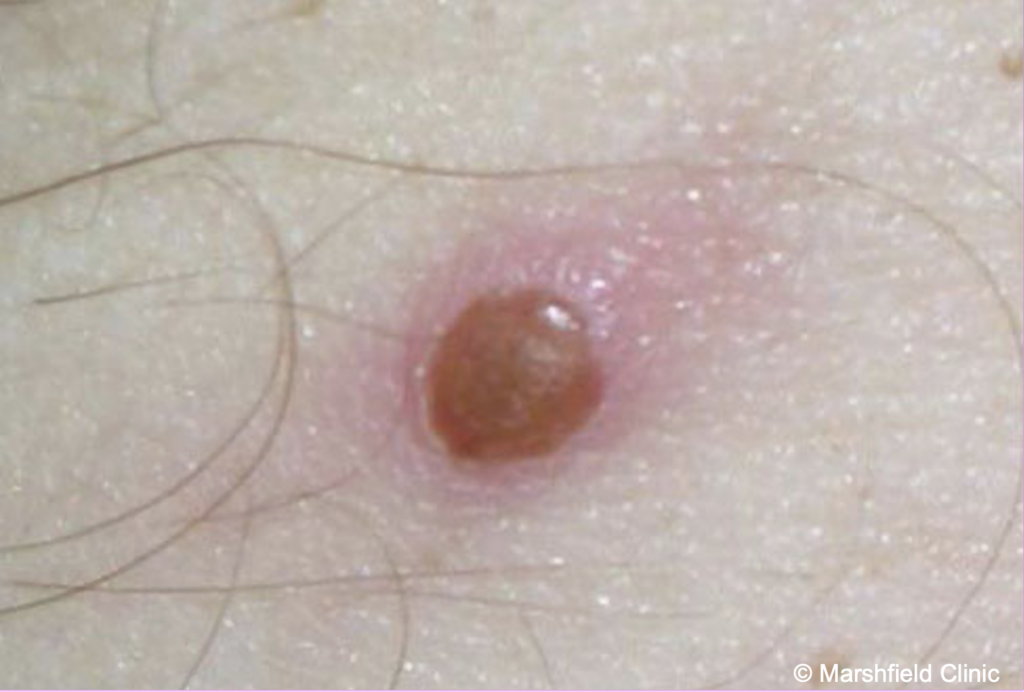
The images that accompany health stories can have a significant impact on people’s understanding, attitudes and behaviors regarding a health issue. I repeatedly beat the drum about using appropriate imagery for stories related to vaccines. But plenty of other health topics have their pitfalls when it comes to imagery.
Key points
- Images accompanying stories about a disease can shape public perception of the disease and those who have it.
- Medical imagery in the media and textbooks has a history of racism and exclusion of people of color.
- Using Black skin images of monkeypox for stories about the current outbreak in predominantly white people perpetuates casual racism by associating Black people with the disease and may lead white people to dismiss their disease risk or not recognize a potential monkeypox rash.
These images from the Marshfield Clinic can be freely used in journalistic stories to illustrate monkeypox on white skin.
The field of dermatology has recently been reckoning with how skin conditions are depicted, whether in news stories, medical textbooks or journals, or other online resources. When nearly all photos of skin conditions are on white skin, doctors may misdiagnose or entirely miss a condition in people of color because the disease looks different on darker skin, potentially harming patients of color. The Journal of the American Academy of Dermatology created a Skin of Color Image Atlas to ensure such images are available to physicians.
But an opposite and just as harmful problem has emerged: Media outlets covering the monkeypox outbreak are frequently using images of Black people even though nearly all cases are among white people.
When I published a recent explainer on monkeypox on the Medium platform, I looked for images in Medium’s photo library but found none of monkeypox. I searched Wikimedia, Creative Commons, and the CDC image library specifically for light-skin images but couldn’t find any. That’s not necessarily surprising since nearly all historical cases have been in western or southern Africans, but it was frustrating. I found some images with white skin on stock photo sites, but as a freelancer, I couldn’t afford to pay out of pocket for the licenses. I finally gave up and used a CDC image of the lesions on Black hands.
By doing so, I contributed to two equally harmful problems: One is that white people may dismiss the images, thinking the condition doesn’t apply to them, or not recognize lesions as possible monkeypox since they’ve only seen them on Black skin. The other is the stigmatization that occurs when the majority of images used to accompany a disease portray only Black people — especially when the global emergency is related to the disease’s spread in mostly white people. It’s bad enough that the global response to monkeypox — with the disease penetrating mostly white, wealthy nations — goes far beyond any past response when thousands of Africans suffered from the disease. It’s worse when media imagery associates a disease outbreak with Africans and Black people while it’s white people spreading the disease.
Casual racism and speaking out
African journalists are speaking up about the problem. The Foreign Press Association, Africa, issued a statement calling for journalists to stop using images of Black people with monkeypox to accompany news stories about the outbreak. African publications and others are pointing out the casual racism of primarily using Black skin images of monkeypox.
On the surface, the problem is understandable given that all the free images I could find online were of Black skin — or at least that’s what I said when a digital sociologist called out my use of a Black skin image in my Medium article on Twitter. But I was wrong.
“You don’t have to serve the article itself with pictures of an ill African person,” they said. “Doing so is a choice that has a material impact on how people perceive the disease. The fact of Black people having had monkeypox is a geographical one, but the representation of that disease visually as only affecting Black people, and particularly dark-skinned Black people at that in western media reproduces the idea that Black people themselves are a disease risk. (It also encourages nonBlack people to dismiss their risk).”
I responded to this valid critique inappropriately and defensively. (I am not linking to the Twitter conversation to protect their privacy and avoid bringing them unwanted attention.) I had sought images with white skin and was frustrated that CDC, and other sources, had none. Images of white skin showed up in Google images, but none I could use for free. I had chosen not to use the black and white image the CDC had, thinking it would be less helpful in identifying the rash, but the sociologist suggested it was a more ethical choice, which I hadn’t considered.
After the Twitter discussion, I spent more time searching for images. I still came up empty, so I asked Twitter for help. A Ph.D. candidate alerted me to a gallery of monkeypox images on light skin that the Marshfield Clinic had previously made available to scientists and the general public following the 2003 U.S. outbreak. (By the way, use of these older images is being exploited by disinformation agents.)
The redesigned Marshfield site no longer had the images, but the Internet Archive did have them. I replaced the image on the Medium story with a white skin image, and since it was unclear who to credit, I credited Marshfield Clinic. The UK Health Security Agency also has some images available, though they’re much smaller.
Even though I had made a good faith effort initially to seek out images of white skin I still contributed to casual racism and potential public health harm by ultimately using a Black skin image. If that was my only option, as it appeared at the time, I could have used a different image at the top and in thumbnails, such as CDC cellular images, and then used the Black hands image lower in the story to illustrate the rash.
The bottom line: Images accompanying stories matter and can shape perceptions of a public health crisis. Journalists have an ethical responsibility to be thoughtful in the ones they choose.








